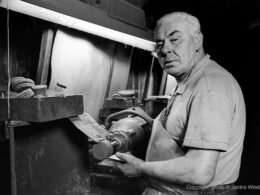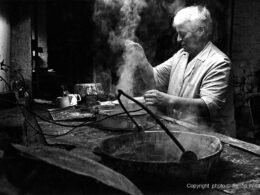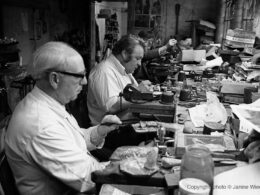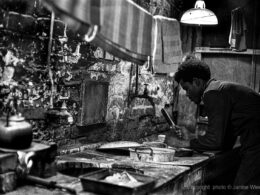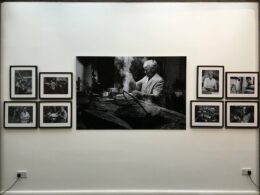
In the 1970’s, American documentary photographer Janine Wiedel won a major photography bursary from West Midlands Arts to document the lives of people in the region. The project saw Janine develop a keen interest and enthusiasm for the industrial heart of Birmingham, which she captured visually during her two-year trip to the region. In 1979 the project resulted in an installation exhibition ‘Vulcan’s Forge’, first shown at the Photographers Gallery, London and then at The ATV, Birmingham and the Stoke-on-Trent City Museum and Art Gallery. A smaller selection became an Ikon Gallery Touring Exhibition.
Janine’s fascination with Birmingham’s industry lead her to the Jewellery Quarter, where she was inspired by the area’s people and their stories. Through her photography, Janine explored the diverse talents and skills of the Jewellery Quarter’s workforce, as well as exploring their unique backgrounds. The sense of community pervasive in the Jewellery Quarter features prominently in the documentary ‘England their England: Camera in the Streets’, which was aired on ATV (now ITV) in 1978. Following Janine’s journey around the West Midlands, ‘Camera in the Streets’ conveys the vibrant personalities within the Jewellery Quarter and showcases the variety of stories they had to share about industry in the West Midlands.
In the documentary, Janine discusses her preference for black and white photo as it removes the distraction of colour and visually brings out form and detail. This helps to illuminate facial expression; Janine’s pictures depict the pride and enthusiasm the workers had for their jobs, whilst also illustrating the close bonds they had with each other. Janine’s photos of workers at Jewellery Quarter firm Turner & Simpson highlight the unique relationship between the workers and their machinery. We had a chat with Janine about her experiences of photographing the Turner & Simpson factory in 1977:
Can you describe what the Jewellery Quarter was like when you photographed the area?
In 1977 the area still had many traces of its beginnings in the early 19th century. It was mostly made up of small firms packed together within the quarter square mile, each working in a specific skill and each dependent on the others to complete the product. The area was in desperate need of renovation and many of the workshops needed more space and equipment but the quality of the work did not reflect the Dickensian atmosphere. Behind the small firms there were often high powered businesses. As the businesses grew, the home workshops extended their premises from one cottage to the next, often building over the space that was once a back yard.
Turner and Simpsons where I spent most of my time was fairly typical of these small family firms. A creaky wooden staircase led up to the first floor landing with a reception desk. From there you would pass along narrow passage-ways, up and down squeaking steps, past door after door, each opening onto separate self contained worlds. Some had 7 or 8 people leaning over fine detailed work. There were wide cluttered surfaces each butted up against the outside wall in order to catch every ray of light passing through the windows. Other rooms were small and dark with no windows but had the same atmosphere, a feeling of ownership. The rooms belonged to the workers, their tools and machinery. The ceiling rafters and wooden floorboards took one back to the makeshift workshops of the last century. the teapots, kettles, individualised brushes and tools all created a feeling of a place where work and companionship were one.
What impression of the West Midlands did you get from the Jewellery Quarter?
The project led me on to photograph other industries of the West Midlands: Forges, steel mills, coal mines, chainmaking and Potteries of Stoke-on-Trent. This area is where the industrial revolution began and its traces were everywhere. Birmingham was still the city of “twelve thousand trades, the small man’s city”. In the 70s whilst there was also an abundance of larger modern factories, the more traditional industries were still surviving and often providing the larger firms with components that couldn’t be mass produced.
Did you hear any particularly inspiring stories from people in the area?
In the Jewellery Quarter I found nearly everyone I spoke with had colourful stories/memories from the area that went back generations. Bill Spooner, had worked there since he was ten and was still coming in at age 70 to do the special hand work. Florence Allen, a gilder, had been with the firm for 35 years and her mother worked as a gilder before her. And her son was also working in the firm as a silversmith. Florence was using a secret formula for gilding passed down to her from her mother. She was only going to pass this on to her son on her deathbed.
Cafe Royal Books have recently published ‘Industry, West Midlands 1977-1978’ a boxset of 7 books: https://www.caferoyalbooks.com/shop/janine-wiedel-industry-west-midlands-19771979
People's Archive page
Explore portraits and oral history interviews from 'Still: Stories from the Jewellery Quarter' exhibition which was on show during October and November 2019.

